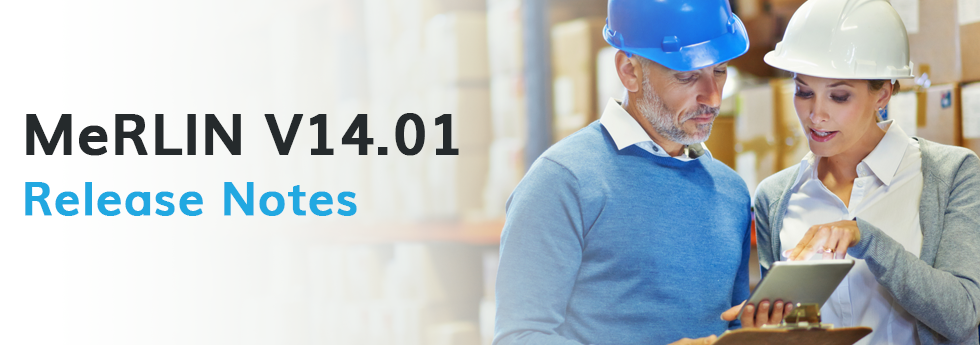Inhaltsverzeichnis
ToggleIntroduction
We are excited to announce that a release of MeRLIN (MeRLIN V14.01) with updates is now live! The updates have been compiled into release notes, providing an overview of the enhancements and fixes in our product that the users anticipated, ensuring that they are up to date with the latest developments.
Strategic Project Management
Project Management
Previously users were required to provide estimates of the number of hours it would take to complete each task. This requirement has now been eliminated, and users are no longer obligated to input estimated hours for tasks. The General Info section of the system, which provides an overview of project details, now calculates the estimated hours for the entire project automatically, by summing up the hours estimated for individual tasks. Validation for data entered by users for projects and estimated task hours has been removed to streamline the process of creating projects.
Lieferantenmanagement
Supplier Data
As part of customization for supplier data, a standard payment term of 60 days for specific customers within the system has been set up.
The configuration option now allows users to tailor the supplier registration form according to their needs by adding or removing the fax number field as required.
The configuration option allows users to customize the supplier registration form by adding or removing fields specifically intended to capture social media information from suppliers. This accommodates varying preferences or requirements related to supplier registration.
The supplier registration form is enhanced by introducing a new address type specifically designed for capturing “Returned to” addresses. This provides users with more options for specifying address information related to returns or other relevant processes.
The configuration option allows users to customize the supplier registration form by adding or removing a feature that collects location data from Google Maps. This customization enhances the accuracy and ease of inputting address information for suppliers during the registration process.
In Germany, the use of IBAN (International Bank Account Number) and BIC (Bank Identifier Code), also known as SWIFT code, is mandatory for banking transactions. To align with these requirements and standards, a configuration option has been implemented that allows users to specify whether IBAN, SWIFT, and account number fields are mandatory or optional when conducting banking transactions within the system.
A configuration option provides flexibility in managing the collection of tax information from suppliers during the registration process. It allows users to customize the supplier registration form based on their specific requirements and compliance needs regarding tax documentation.
A configuration ensuring consistency and efficiency in the supplier registration process by automatically assigning a default payment term based on the supplier’s type has been added. It simplifies the registration process for suppliers and ensures that the appropriate payment terms are applied consistently across different supplier types.
A new update enhances user comprehension and utilization of the features related to supplier contacts within the system by providing detailed descriptions of their roles and functionalities.
The country codes associated with phone numbers are now organized in ascending alphabetical order of country names in the system, making it easier for users to locate and select the desired country code when entering phone numbers.
Supplier Management
The Supplier Document Repository feature now provides a centralized and organized way to store and manage all supplier-related documents within the system. It offers users a view of these documents and the flexibility to control document visibility as needed.
A new update expands the capabilities of users with the Vendor Master role by granting them the authority to change the Responsible Buyer for suppliers, regardless of their approval status. This ensures greater flexibility and continuity in supplier management processes within the system, even when a responsible buyer is not available.
Lieferanten-Onboarding
A new option permits users to proceed with the questionnaire or survey responses even if they choose not to upload any documents within the “Documents” tab during the supplier onboarding process.
An update has been made that allows users to rearrange questions newly added to surveys or questionnaire templates. Now, users have the flexibility to organize questions in a more logical and structured manner, facilitating easier management of surveys and questionnaires.
Users must now consent to a privacy policy outlining data security measures before providing personal information within the system. A new measure is implemented to ensure legal compliance with regulations concerning data privacy and security.
A new improvement simplifies the supplier onboarding process by automatically transferring qualification information (with the questions answered during qualification to be automatically populated in the onboarding questionnaire) to the registration phase, thus reducing duplication of effort for supplier users.
An update now improves efficiency and convenience in the supplier onboarding process by introducing the ability to upload supplier information in bulk using an Excel file. It allows users to onboard multiple suppliers in a single step, saving time and effort.
The supplier onboarding process has been enhanced with improved guidance and support for suppliers, and refinements to promote better communication and collaboration between suppliers and the buying organization. These enhancements aim to make the onboarding process smoother, more efficient, and more collaborative for all parties involved.
A series of enhancements aimed at refining the supplier onboarding process has been made, with a particular focus on reinforcing the recall functionality to ensure that users can easily access and retrieve pertinent information as needed.
Integration
The credit management process has been enhanced by extending the Creditreform Interface to include features for managing company financial risk and credit rating information. It enables more comprehensive credit risk assessment and monitoring within the system.
Sourcing
RFQ
When suppliers are providing quotations for goods or services, they are required to use a specific unit of measurement (UoM) requested by the buyer. This eliminates errors that could occur if suppliers were allowed to quote in different units of measurement.
Auction
By including elements like item details, units of measurement, currency, payment terms, item prices, Incoterms, Incoterms location, total amounts, delivery dates, as well as questions and answers, and ranking information in auction comparisons, stakeholders can make informed decisions when selecting suppliers and awarding contracts, ultimately optimizing the procurement process.
When a supplier is awarded a contract, they now receive a package of information detailing various aspects of the agreement like quantity and amount, incoterm location, delivery date/term, and milestones (for services).
Users now can upload more than one line item at a time for an auction. Users can utilize an Excel file to update multiple items and upload that file directly into the system during auction creation.
Contract Management
Non-catalogue items can be included in the contract pricelist, even though they were not originally part of any catalogue, they can now be included in the pricing structure for a specific contract. Once these non-catalogue items are added to the contract pricelist, they will be treated as if they were catalogue items for subsequent processes, so that when creating purchase orders (POs) or other documents downstream in the procurement process, these items will be available for selection as if they were part of the standard catalogue.
Insurance and Guarantee fields of the contract section can be chosen to be removed from the section entirely if they do not apply to a particular contract or if users prefer not to include them in their contracts.
In the contracts section, there will be a designated field to specify the Incoterm location, which will vary based on the type of Incoterm chosen for that particular contract. This addition ensures clarity and specificity regarding the transfer of responsibilities and risks between parties in international trade contracts.
It is now possible to create a contract without including any stakeholders whatsoever. This means that the inclusion of stakeholders in the contract creation process is now entirely optional. This update offers users the flexibility to determine the level of stakeholder involvement based on the specific requirements of each contract.
A new functionality indicates a change in the process of contract creation within the system regarding alerts and notifications. In the updated system, it is now possible to create a contract without setting up any alerts or notifications. This means that the inclusion of alerts and notifications in the contract management process is now entirely optional because some contracts may be straightforward or have less time-sensitive terms, making alerts and notifications unnecessary.
Contract Authoring
The registration approval and signature of the suppliers have been synchronized into a single step, streamlining document handling and enhancing efficiency.
While creating and drafting a contract, when users select the template and input the necessary data into these fields, the template now automatically merges the data into the appropriate places within the contract. Users can see the merged content immediately after selecting the template, rather than having to manually input all the information into the contract themselves.
Compliance
Audit
The system is set to send reminder for any upcoming audits to suppliers.
Compliance
Users can refine the scope of the compliance survey by filtering suppliers based on their specific type or classification. This enhances the functionality of the Compliance Survey feature, allowing for a more targeted and efficient assessment of supplier compliance based on different supplier types.
Compliance Users can selectively exclude suppliers who have been blacklisted from the compliance survey process. This provides greater control and flexibility in managing compliance assessments and ensures that only compliant suppliers are included in the surveys or schedules.
A new update allows users to have a “Save as Draft” functionality available when responding to the survey from the Supplier portal and not while accessing it through an email-based link. It aims to prevent confusion and ensure users are aware of the limitations of the feature based on their mode of access.
All the responses to surveys by suppliers are now visible to suppliers. Compliance Managers can now review the responses and make changes, if required, along with reasons. Such changes made by the compliance managers will also be visible to Suppliers.
The users can now manually assign weightage to questions in templates such as the Compliance Survey Template and the In-person Audit Template. These templates typically involve single-choice answers, and users should be able to assign weightage to questions even if there are more than two possible answers.
New feature that limits access to email templates depending on the user’s permissions determined by the license management settings has been added.
Risiko-Management
In the risk management tab, new risks can be created, existing risks can be edited and managed by a single user. Only in case of closing a resolved risk, approvals from a risk manager will be needed before closing the risk.
LkSG
While scheduling a survey for the suppliers, it is now possible to select Suppliers by Name in addition to the existing capability of selecting by Criteria.
Security
MeRLIN received a SOC2 Type 1 Compliance Certificate in Q1-2024 for its robust data security and information management standards.
Supplier Management
While onboarding a supplier, a “Compliance Survey” can now be sent out to the suppliers to determine their compliance status before confirming supplier onboarding.
The Vendor Master role has been expanded to provide comprehensive access to all suppliers involved in the onboarding process, ensuring seamless oversight and management of supplier relationships throughout the onboarding journey.
Platform
Supplier Management
The user interface (UI) and user experience (UX) have undergone significant enhancements in the supplier registration information form, aimed at improving the overall usability and efficiency of the registration process for both users and suppliers alike.
Analytik
Users will only see dashboard widgets that are relevant to the modules they have licensed. Widgets associated with unlicensed modules will be hidden or unavailable for selection. It prevents users from attempting to use features that are not included in their subscription.
Integration
By obtaining the Creditreform number from suppliers and accessing detailed credit reports through the buyer portal, businesses can make more informed decisions regarding their supplier relationships and mitigate potential financial risks. The Creditreform report would contain detailed information and analysis regarding the creditworthiness and risk profile of the supplier.
The new update has made sure that both suppliers and buyers can search for a Creditreform number. If a supplier doesn’t provide this number, the user can include it. The goal is to ensure consistency in format and style with existing Creditreform information.
New functionality in both the Supplier and Buyer portals to search for the Creditreform (CR) number using specified criteria (such as Name and Country) has been created. The capability to update the CR number in the Buyer portal has been added. Also included is the capability to store the details of CR report as PDFs in the Supplier Document repository, for housing Creditreform reports associated with suppliers.
Delegation
This is a comprehensive update to the delegation and transfer functionality within the system, with a specific focus on introducing an “Out Of Office” setup feature. This enhancement aims to improve efficiency and ensure continuity of operations even when key individuals are temporarily unavailable.



